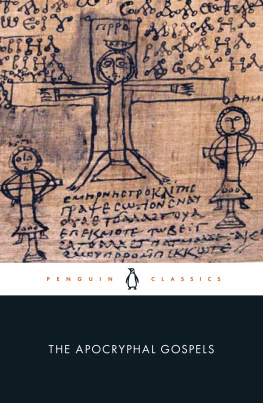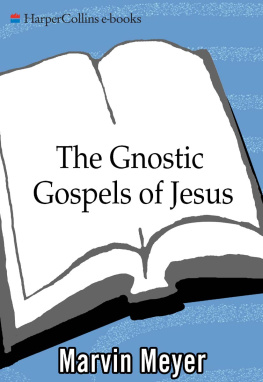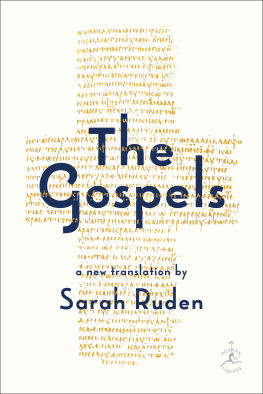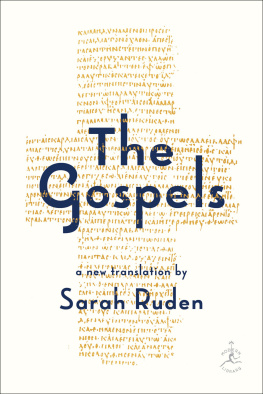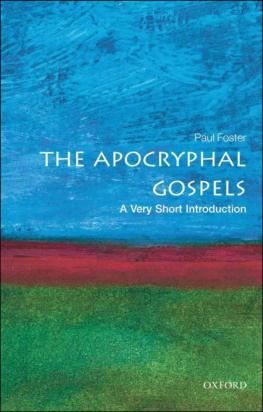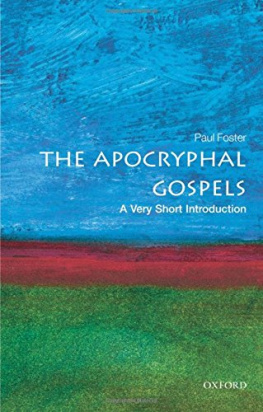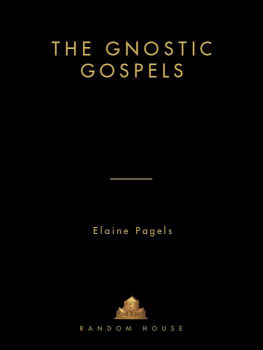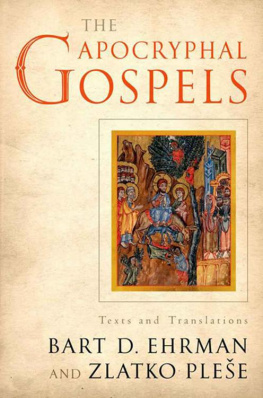About the Author
SIMON GATHERCOLE received a double First in Classics and Theology at Kings College, Cambridge, and studied further at the Jewish Theological Seminary in New York and the Universities of Tbingen and Durham. He has written several books on the New Testament and apocryphal Christian literature, and is editor of the journal New Testament Studies. He is Professor of New Testament and Early Christianity at the University of Cambridge, and a Fellow of Fitzwilliam College, Cambridge.
Translated with an Introduction by
Simon Gathercole
THE APOCRYPHAL GOSPELS

PENGUIN BOOKS
UK | USA | Canada | Ireland | Australia
New Zealand | India | South Africa
Penguin Books is part of the Penguin Random House group of companies whose addresses can be found at global.penguinrandomhouse.com.

First published in Penguin Classics 2021
Translation and editorial material copyright Simon Gathercole, 2021
Translation of The Epistle of the Apostles copyright Francis Watson, 2021
The moral rights of the translator have been asserted
Cover: detail of the Crucifixion from a 6th-century Coptic magical text, papyrus, Or 6796 British Library Board
All Rights Reserved/Bridgeman Images
ISBN: 978-0-241-34056-1
This ebook is copyright material and must not be copied, reproduced, transferred, distributed, leased, licensed or publicly performed or used in any way except as specifically permitted in writing by the publishers, as allowed under the terms and conditions under which it was purchased or as strictly permitted by applicable copyright law. Any unauthorized distribution or use of this text may be a direct infringement of the authors and publishers rights and those responsible may be liable in law accordingly.
Introduction
The Gospels could not possibly be either more or less in number than they are. So wrote St Irenaeus, Bishop of Lyons, around 180 CE . This statement is no mere platitude, but a sharply combative insistence that the four canonical Gospels of Matthew, Mark, Luke and John were the only path to the truth. In Irenaeus line of fire were some rival groups who used fewer than four Gospels only a mutilated version of Luke, for example, or an amalgam of the four Gospels rolled into one. At the same time, he was targeting heretics who had minted additional Gospels such as the Gospel of Truth or the Gospel of Judas. In Irenaeus view, to deviate in either direction from the fourfold nature of the Gospel was to invite the curse spelled out in the closing words of the Book of Revelation: If anyone adds anything to them, God will add to that person the plagues described in this scroll. And if anyone takes words away from this scroll of prophecy, God will take away from that person any share in the tree of life and in the Holy City.
For Irenaeus and others like him, the books in the fourfold Gospel collection went hand in hand with the way many in the early church understood the message of the good news which they preached. These Gospels now in our New Testament were the four accounts understood to encapsulate the truth of the incarnation, death and resurrection of Jesus Christ. These four had been handed down from the time of Jesus apostles, in contrast to recent arrivals produced by unorthodox sects. Perhaps above all, since Irenaeus was writing in the midst of vicious Roman persecution, the canonical Gospels provided not just group solidarity but the message of eternal life with God. Many agreed with the Bishop of Lyons: the canonical Gospels were generally the most widely copied and quoted, and in Irenaeus time many across the breadth of the Roman Empire had adopted the same fourfold Gospel.
Popular though the four Gospel collection may have been, however, Irenaeus and the other church leaders of his day could not enforce it. In the first three centuries CE , Christians had no legal mandate or military muscle enabling the church to insist on four, and only four, Gospels. Even under Constantine (emperor 306337 CE ), orthodox Christianity was not the official religion of the Roman Empire as is sometimes thought. The so-called Edict of Milan in 313 merely granted Christianity tolerated legal status. It was not until the Edict of Thessalonica in 380 that the three co-emperors of the time decreed: It is our will that all peoples, over whom the measure of our mercy reigns, abide in the religion which the divine apostle Peter passed down to the Romans. Before this time, there were no enforceable punishments that could be meted out to dissident religious groups.
Despite Irenaeus solemn declaration, then, various groups in early Christian times produced apocrypha. This term, from the Greek apokruphos, meaning hidden or secret, came to refer to any books which exercised undue allure or which trespassed on the contents of the Bible by supplementing or replacing the ground it covered. These apocrypha came in various forms. There were apocryphal epistles attributed to disciples of Jesus, and other apocalypses besides the Revelation of St John in the New Testament. The label Gospel was especially potent, however, since it laid claim to the good news, the literal meaning of the Greek word for Gospel, euangelion. Calling a book a Gospel was a claim to have the truth about Jesus and the message of new life.
Having this label did not necessarily mean that a Gospel author would rewrite the historical story of Jesus in Galilee and Judaea c. 30 CE , however. Gospel on its own is not a literary genre, but a title referring to the good news of salvation by Jesus. The form that the text took depended on what kind of salvation the author considered Jesus to have brought. Some apocryphal Gospels do imitate the canonical Gospels of Matthew, Mark, Luke and John. Marcions Gospel, the Gospel of Peter and Tatians Diatessaron all adopt the established biographical, narrative form and so see the good news as rooted in Jesus activity in history. Other works strike out in different directions, consisting of dialogues between the risen Jesus and certain disciples, or setting out the divine plan of salvation in pithy oracles. In a Gospel which is a catalogue of sayings, like the Gospel of Thomas, the medium is the message: interpreting Jesus enigmatic utterances is what brings salvation. Still other Gospels resemble myths about the genesis of the Greek pantheon, with Jesus revealing the redemptive knowledge of how the different parts of the divine realm came into being.
Alongside the texts called Gospels in their manuscripts or by other writers, there is also a large body of other Gospel material. Some works are not designed to contain the message of salvation as such, but speculate on additional details of the life of Jesus not included in the New Testament Gospels. Infancy Gospels imagine what Jesus got up to as a child, for example. Passion texts, centred on the trial and death of Jesus, offer conjectures on the legal wranglings behind the decision to sentence Jesus to death, or supply further dialogue between Jesus and the criminals crucified with him. Like the theologians of the early church, modern scholars classify these texts as apocryphal Gospels as well. A particular problem arises with very small manuscript fragments referring to Jesus and his disciples. These tend to be labelled immediately as Gospels, but they could equally be fragments of sermons or commentaries or some other genre. The translations in this edition encompass all these kinds of apocryphal Gospel texts, which cover a very diverse array of material by many different authors. The literature included here is not intended to present the other Jesus, as if the apocryphal Gospels all joined forces to recount an alternative life of Christ. Rather, the aim of this volume is to present the earliest apocryphal Gospel literature (mostly from before 300 CE ) in all its different styles, theologies and perspectives heavenly or earthly.

